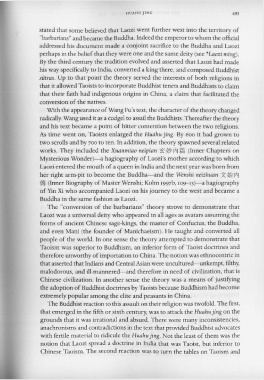Page 533 - The Encyclopedia of Taoism v1_A-L
P. 533
HUAH U JI NG 493
stated that some believed that Laozi went further west into the territory of
'barbarians" and became the Buddha. Indeed the emperor to whom the official
addressed his document made a conjoint sacrifice to the Buddha and Laozi
perhaps in the belief that they were one and the same deity (see *Laozi ming).
By the third century the tradition evolved and asserted that Laozi had made
his way specifically to India, converted a king there, and composed Buddhist
sutras. Up to that point the theory served the interests of both religions in
that it allowed Taoists to incorporate Buddhist tenets and Buddhists to claim
that their faith had indigenous origins in China, a claim that facilitated the
conversion of the natives.
With the appearance of Wang Fu's text, the character of the theory changed
radically. Wang used it as a cudgel to assail the Buddhists. Thereafter the theory
and his text became a point of bitter contention between the two religions.
As time went on, Taoists enlarged the Huahu jingo By 600 it had grown to
two scrolls and by 700 to ten. In addition, the theory spawned several related
works. They included the Xuanmiao neipian K"if) pg ~ (Inner Chapters on
Mysterious Wonder)-a hagiography of Laozi's mother according to which
Laozi entered the mouth of a queen in India and the next year was born from
her right arm-pit to become the Buddha-and the Wenshi neizhuan xP#i pg
1$ (Inner Biography of Master Wenshi; Kohn 1997b, I09-13)-a hagiography
of Yin Xi who accompanied Laozi on his journey to the west and became a
Buddha in the same fashion as Laozi.
The "conversion of the barbarians" theory strove to demonstrate that
Laozi was a universal deity who appeared in all ages as avatars assuming the
forms of ancient Chinese sage-kings, the master of Confucius, the Buddha,
and even Mani (the founder of Manichaeism). He taught and converted all
people of the world. In one sense the theory attempted to demonstrate that
Taoism was superior to Buddhism, an inferior form of Taoist doctrines and
therefore unworthy of importation to China. The notion was ethnocentric in
that asserted that Indians and Central Asian were uncultured- unkempt, filthy,
malodorous, and ill-mannered-and therefore in need of civilization, that is
Chinese civilization. In another sense the theory was a means of justifying
the adoption of Buddhist doctrines by Taoists because Buddhism had become
extremely popular among the elite and peasants in China.
The Buddhist reaction to this assault on their religion was twofold. The first,
that emerged in the fifth or sixth centUry, was to attack the Huahu jing on the
grounds that it was irrational and absurd. There were many inconsistencies,
anachronisms and contradictions in the text that provided Buddhist advocates
with fertile material to ridicule the Huahujing. Not the least of them was the
notion that Laozi spread a doctrine in India that was Taoist, but inferior to
Chinese Taoism. The second reaction was to turn the tables on Taoism and

